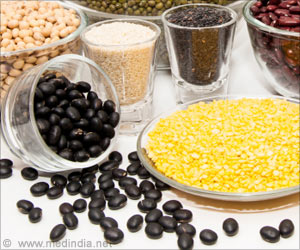Eating whole grains such as oats, wheat and rye can help prevent type 2 diabetes. Type of wholegrain product does not matter but how much a person consumes per day is important.

‘Eating the right amount of whole grains such as oats, wheat and rye can help prevent type 2 diabetes.’





The ability to use whole grains for prevention of type 2 diabetes - previously sometimes known as adult-onset diabetes - has been known for a long time. But the role of different wholegrain sources has not been investigated. It has also been unclear how much whole grain is needed to reduce the risk of developing diabetes."Most studies similar to ours have previously been conducted in the USA, where people mainly get their wholegrain from wheat," says Rikard Landberg, Professor in Food and Health at Chalmers University of Technology, and senior researcher on the study.
"We wanted to see if there was a difference between different cereals. One might expect there would be because they contain different types of dietary fiber and bioactive substances, which have been shown to influence risk factors for type 2 diabetes."
The study was conducted in Denmark, where there is a big variation in wholegrain-intake. The study showed that it made no difference which type of whole grain product or cereal the participants ate - rye bread, oatmeal, and muesli, for example, seem to offer the same protection against type 2 diabetes.
What is more important is how much whole grain one eats each day - and the study also provides important clarification to the scientific knowledge when it comes to daily dosages.
Advertisement
The proportion who developed type 2 diabetes was lowest in the group which reported the highest wholegrain consumption and increased for each group which had eaten less wholegrain. In the group with the highest whole grain intake, the diabetes risk was 34 percent lower for men, and 22 percent lower for women, than in the group with the lowest wholegrain intake.
Advertisement
Additionally, the study was uncommonly large, with 55,000 participants, over a long time span - 15 years.
If you compare wholegrains' role in the risk of developing type 2 diabetes against other foods that have been investigated in other studies, it is one of the most effective ways to reduce the risk when it comes to diet. Drinking coffee, and avoiding red meat, are other factors that can similarly reduce the risk of type 2 diabetes.
"Our results are in line with dietary advice, which recommends switching out foods containing white flour for whole grains," says Rikard Landberg.
"You get extra health benefits - white flour has some negative effects on health, while wholegrain has several positive effects, beyond protection against type 2 diabetes."
Wholegrains are defined as consisting of all three main components of the grain kernel: endosperm, germ, and bran. Those who avoid all cereals, in an attempt to follow a low carb diet, therefore lose out on the positive health effects of wholegrain, which come principally from the bran and the germ. Rikard Landberg thinks that cereals, and carbohydrates in general, should not be avoided in diet.
"Carbohydrates are a very varied group of foodstuffs, including sugar, starch, and fiber. We should discuss these more individually, and not throw them together in one group, because they have totally different effects on our physiology and health. When it comes to whole grains, the research results are clear: among the many studies which have been made, in varied groups of people around the world, there hasn't been a single study which has shown negative health effects."
More on: Whole grains
Whole grains consist of all three main components of the grain kernel: endosperm, germ, and bran. It can be both loose grains, and wholegrain flour. Grains such as oatmeal and rye, wheat berries, bulgur, and wholegrain couscous are all whole grains. In bread and pasta, the wholegrain content can vary. Common cereals include wheat, rye, oats, corn, maize, rice, millet, and sorghum.
Swedish dietary advice is to eat around 70g of whole grain a day for women, and 90g a day for men. Some examples of how much whole grain different foods contain:
- 1 50g slice of rye bread: 16 g wholegrain
- 1 35g serving of oatmeal porridge: 35 g wholegrain
- 1 12g crispbread: 12 g wholegrain
More on: The Study
The study used data from a prospective Danish cohort study on diet, cancer, and health. It covered more than 55,000 participants, who were between 50-65 years old when the study started.
During the initiation of the cohort study in the early 1990s, healthy participants had filled in detailed forms of their eating habits. Through these, the researchers established the participants' total wholegrain intake per day, which of the most common cereals they got their wholegrain from, (wheat, rye, oats, in grams per day), and the total number, and different types, of wholegrain products (in grams per day) - rye bread, other wholegrain breads, oatmeal porridge and muesli.
The cohort study was linked with data from Denmark's national diabetes register, to investigate which participants developed type 2 diabetes during a 15 year period - which in total was over 7000 people.
Source-Eurekalert














